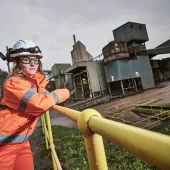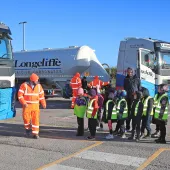Elevating Safety
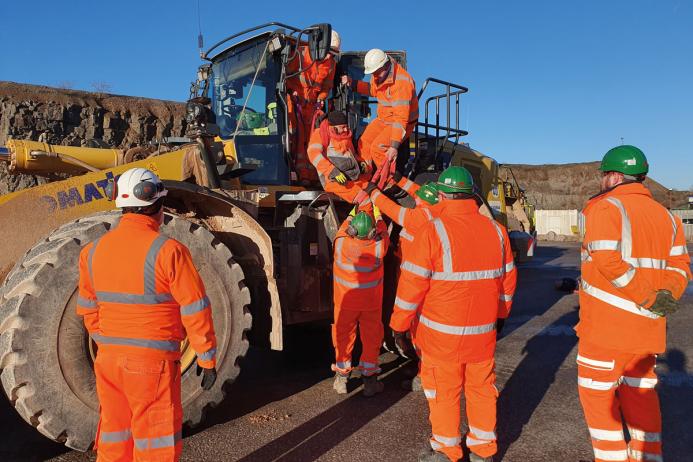
First published in the November 2025 issue of Quarry Management
Specialist training for quarry vehicle cab rescue
The quarrying industry continues to make major strides in health and safety, but certain scenarios remain complex and less frequently practised. One of these is the safe rescue of an operator from a quarry vehicle cab, a situation that combines the risks of height, restricted space, and time pressure.
Large quarry vehicles such as dumptrucks, loading shovels, and excavators are designed for visibility, durability, and protection. However, when an operator becomes incapacitated, those same design features can turn into significant obstacles for rescuers. Elevated cabs are often 2m or more above the ground, accessed by narrow or curving steps. Inside, the confined space leaves little room for movement.
This year, Abacus Training Centre Ltd partnered with Aggregate Industries (part of the Holcim Group) to deliver specialist training focused on this exact, critical scenario at two of their quarry sites, Cauldon Low in Staffordshire and Hillhead in Devon. The programme was designed to instil the confidence and practical skills required to extricate and lower a casualty safely, without relying solely on external emergency services. The proactive initiative was later highlighted in the company’s internal health and safety communications.
The triple threat: Height, access, and the race against time
When an operator cannot exit a cab under their own power, every minute counts. Access routes on quarry vehicles are narrow and often offset to the side, forcing rescuers to work in awkward positions. The confined cab adds further difficulty: the casualty must often be moved on an angle to avoid seats, safety frames, and control panels, all while protecting the spine and maintaining airway management.
Even once freed from the cab, the problem of height remains. Lowering an injured person 2m or more to the ground without suitable equipment or training can easily lead to a serious secondary injury, either to the casualty or to the rescuers attempting to assist.
The reality of quarry operations also means that emergency services may face delays reaching remote or uneven sites. While fire and rescue teams have the expertise to perform complex extrications, they may not be immediately familiar with specific quarry vehicle designs. A trained on-site response team is, therefore, the invaluable first line of action, able to initiate a safe process while professional assistance is en route.
Engineering a bespoke, practical rescue solution
To address these specific challenges, Abacus Training developed a bespoke, scenario-based course designed exclusively for quarry environments. The programme combines classroom theory with practical, hands-on rescue simulations that mirror real-world conditions.
Key elements of the specialist course include:
Hazard and scene assessment – Understanding the risks associated with vehicle structure, terrain, and casualty condition before any physical contact is made
Cab extrication techniques – Safely manoeuvring a casualty within confined spaces, using appropriate lifting aids and teamwork to minimize movement and strain
Controlled lowering methods – Transferring the casualty from the elevated cab to ground level in a stable and protected manner
Communication and co-ordination – Assigning clear roles within the rescue team and maintaining calm, structured dialogue throughout the process.
These principles are reinforced through live demonstrations, small group exercises, and full scenario simulations. The emphasis is on learning by doing, allowing participants to test, adapt, and repeat techniques until they become second nature.
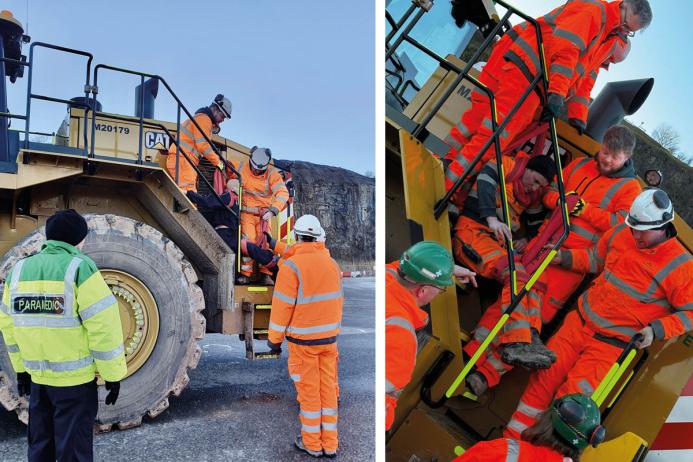
Building confidence through simulation: Voices from the course
That practical, team-based element, using equipment, handling weighted dummies, and practising lowering techniques builds not just technical skill but trust and confidence among colleagues.
As one course participant, Madeleine B, explained: ‘The practical was very useful and [it] was good to have the discussions around rescue options in a training situation.’ Her feedback reflects the importance of a safe environment in which quarry teams can explore and debate different approaches before they are needed in a real emergency.
Another delegate, James G, added: ‘Hands-on learning with the dummies and then with each other demonstrated how using the straps correctly affects the patient...Very good course, trainers very good, and very interesting course to learn.’
From theory to readiness
Participants reported that the training made them think differently about incident management and their own preparedness. Damian H summarised it well: ‘Very useful...the course makes you think how you would apply methods at [your] place of work.’
That reflection is vital. Each quarry layout, each type of machine, and each team structure is different. The aim is to give learners adaptable principles they can apply in their operational context, rather than rigid procedures. By rehearsing these rescues in controlled conditions, teams also gain a clearer understanding of the limitations of their existing equipment and what additional resources might be needed, from rescue straps and stretchers to anchor points and height safety gear.

Tangible benefits for quarry operators
The benefits of such focused training extend well beyond compliance.
Rapid on-site response – Staff can initiate a safe and effective rescue immediately, significantly reducing casualty time to care
Reduced risk of further injury – Practised techniques prevent panic responses and improvised manoeuvres that could worsen the casualty’s condition
Improved team confidence – Knowing what to do and having rehearsed it allows quarry teams to respond calmly under pressure
Demonstrated duty of care – Providing training for foreseeable but high-risk scenarios shows a clear commitment to employee welfare and legal responsibility.
Following the Staffordshire and Devon sessions, Aggregate Industries staff felt far more confident in their ability to manage this type of emergency. The training also prompted reviews of on-site rescue plans, ensuring procedures were clearly defined and equipment easily accessible.
Embedding preparedness into quarry safety culture
The quarrying sector has made significant progress in embedding safety culture, but maintaining that momentum depends on continuously identifying emerging or neglected risks. Elevated cab rescues are a prime example of a low-frequency, high-impact event that can quickly turn serious if staff are unprepared.
While the focus of many safety initiatives is rightly on preventing incidents in the first place, preparedness for emergency response is equally critical. As quarry vehicles evolve, often becoming larger, heavier, and more complex, so too must the industry’s approach to rescue readiness. Training of this kind builds more than technical ability; it creates a mindset of anticipation and composure.
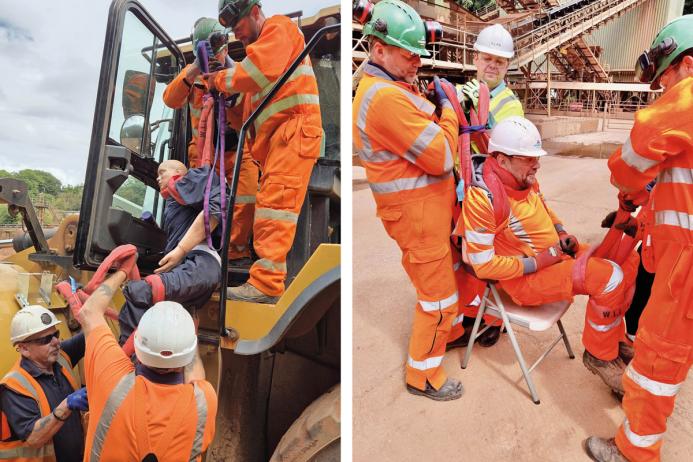
Conclusion
Rescuing an incapacitated operator from an elevated quarry cab is among the most technically demanding scenarios that quarry personnel might face. It requires knowledge of working at height, casualty care, and confined space manoeuvring, all in an environment where time and safety margins are tight.
The work undertaken by Abacus Training and Aggregate Industries shows how targeted, practical education can successfully fill this gap. Through structured exercises, realistic simulations, and open discussion, quarry teams can develop the competence and confidence to respond effectively when it matters most. As the industry continues its drive toward zero harm, such preparedness should form a key part of every operator’s emergency planning. Real safety is not just about preventing incidents; it is about being ready for them.
Subscribe to Quarry Management, the monthly journal for the mineral products industry, to read articles before they appear on Agg-Net.com


